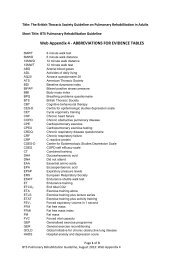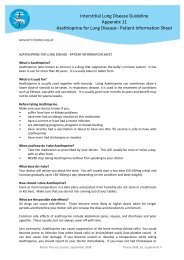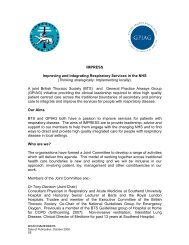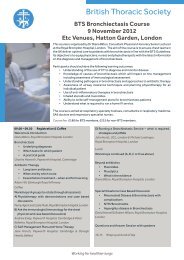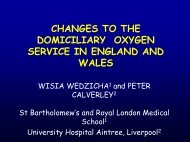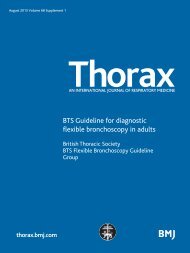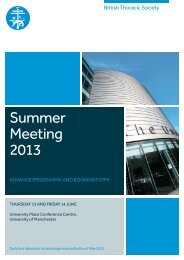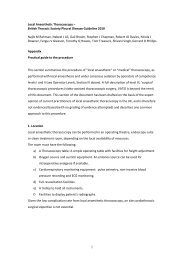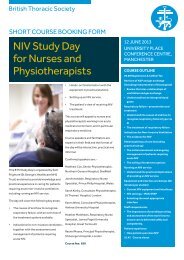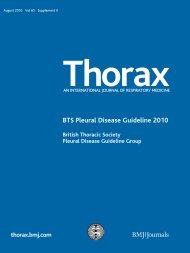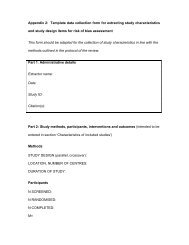Guidelines for the management of community ... - Brit Thoracic
Guidelines for the management of community ... - Brit Thoracic
Guidelines for the management of community ... - Brit Thoracic
You also want an ePaper? Increase the reach of your titles
YUMPU automatically turns print PDFs into web optimized ePapers that Google loves.
BTS guidelines<br />
Empirical antibiotic choice <strong>for</strong> adults hospitalised with high severity<br />
CAP<br />
96. Patients with high severity pneumonia should be treated<br />
immediately after diagnosis with parenteral antibiotics.<br />
[B2]<br />
97. An intravenous combination <strong>of</strong> a broad-spectrum b-<br />
lactamase stable antibiotic such as co-amoxiclav toge<strong>the</strong>r<br />
with a macrolide such as clarithromycin is preferred. [C]<br />
98. In patients allergic to penicillin, a second-generation (eg,<br />
cefuroxime) or third-generation (eg, cefotaxime or ceftriaxone)<br />
cephalosporin can be used instead <strong>of</strong> coamoxiclav,<br />
toge<strong>the</strong>r with clarithromycin. [C]<br />
When should <strong>the</strong> intravenous or <strong>the</strong> oral route be chosen?<br />
99. The oral route is recommended in those with low and<br />
moderate severity CAP admitted to hospital provided <strong>the</strong>re<br />
are no contraindications to oral <strong>the</strong>rapy. [B+]<br />
When should <strong>the</strong> intravenous route be changed to oral?<br />
100. Patients treated initially with parenteral antibiotics should be<br />
transferred to an oral regimen as soon as clinical improvement<br />
occurs and <strong>the</strong> temperature has been normal <strong>for</strong> 24 h,<br />
providing <strong>the</strong>re is no contraindication to <strong>the</strong> oral route.<br />
Pointers to clinical improvement are given in box 4. [B+]<br />
101. The choice <strong>of</strong> route <strong>of</strong> administration should be reviewed<br />
initially on <strong>the</strong> ‘‘post take’’ round and <strong>the</strong>n daily. [D]<br />
102. Ward pharmacists could play an important role in<br />
facilitating this review by highlighting prescription charts<br />
where parenteral antibiotic <strong>the</strong>rapy continues. [D]<br />
Which oral antibiotics are recommended on completion <strong>of</strong><br />
intravenous <strong>the</strong>rapy?<br />
103. The antibiotic choices <strong>for</strong> <strong>the</strong> switch from intravenous to<br />
oral are straight<strong>for</strong>ward where <strong>the</strong>re are effective and<br />
equivalent oral and parenteral <strong>for</strong>mulations. [C]<br />
104. In <strong>the</strong> case <strong>of</strong> parenteral cephalosporins, <strong>the</strong> oral switch to<br />
co-amoxiclav 625 mg three times daily is recommended<br />
ra<strong>the</strong>r than to oral cephalosporins. [D]<br />
105. For those treated with benzylpenicillin + lev<strong>of</strong>loxacin, oral<br />
lev<strong>of</strong>loxacin with or without oral amoxicillin 500 mg–1.0 g<br />
three times daily is recommended. [D]<br />
How long should antibiotics be given <strong>for</strong>?<br />
106. For patients managed in <strong>the</strong> <strong>community</strong> and <strong>for</strong> most<br />
patients admitted to hospital with low or moderate<br />
severity and uncomplicated pneumonia, 7 days <strong>of</strong> appropriate<br />
antibiotics is recommended. [C]<br />
107. For those with high severity microbiologically-undefined<br />
pneumonia, 7–10 days <strong>of</strong> treatment is proposed. This may<br />
need to be extended to 14 or 21 days according to clinical<br />
judgement; <strong>for</strong> example, where Staphylococcus aureus or<br />
Gram-negative enteric bacilli pneumonia is suspected or<br />
confirmed. [C]<br />
Failure <strong>of</strong> initial empirical <strong>the</strong>rapy<br />
108. When a change in empirical antibiotic <strong>the</strong>rapy is considered<br />
necessary, a macrolide could be substituted <strong>for</strong> or<br />
added to <strong>the</strong> treatment <strong>for</strong> those with low severity<br />
pneumonia treated with amoxicillin mono<strong>the</strong>rapy in <strong>the</strong><br />
<strong>community</strong> or in hospital. [D]<br />
109. For those with moderate severity pneumonia in hospital<br />
on combination <strong>the</strong>rapy, changing to doxycycline or a<br />
fluoroquinolone with effective pneumococcal cover are<br />
alternative options. [D]<br />
110. Adding a fluoroquinolone is an option <strong>for</strong> those with high<br />
severity pneumonia not responding to a b-lactam/macrolide<br />
combination antibiotic regimen. [D]<br />
Avoiding inappropriate antibiotic prescribing<br />
111. The diagnosis <strong>of</strong> CAP and <strong>the</strong> decision to start antibiotics<br />
should be reviewed by a senior clinician at <strong>the</strong> earliest<br />
opportunity. There should be no barrier to discontinuing<br />
antibiotics if <strong>the</strong>y are not indicated. [D]<br />
112. The indication <strong>for</strong> antibiotics should be clearly documented<br />
in <strong>the</strong> medical notes. [D]<br />
113. The need <strong>for</strong> intravenous antibiotics should be reviewed<br />
daily. [D]<br />
114. De-escalation <strong>of</strong> <strong>the</strong>rapy, including <strong>the</strong> switch from<br />
intravenous to oral antibiotics, should be considered as<br />
soon as is appropriate, taking into account response to<br />
treatment and changing illness severity. [D]<br />
115. Strong consideration should be given to narrowing <strong>the</strong><br />
spectrum <strong>of</strong> antibiotic <strong>the</strong>rapy when specific pathogens are<br />
identified or when <strong>the</strong> patient’s condition improves. [D]<br />
116. Where appropriate, stop dates should be specified <strong>for</strong><br />
antibiotic prescriptions. [D]<br />
Optimum antibiotic choices when specific pathogens have been<br />
identified<br />
117. If a specific pathogen has been identified, <strong>the</strong> antibiotic<br />
recommendations are as summarised in table 6. [C]<br />
Specific issues regarding <strong>the</strong> <strong>management</strong> <strong>of</strong> Legionnaires’ disease<br />
118. As soon as a diagnosis <strong>of</strong> legionella pneumonia has been<br />
made, <strong>the</strong> clinician should liaise with <strong>the</strong> clinical microbiologist<br />
to confirm that <strong>the</strong> local Health Protection Unit<br />
has been in<strong>for</strong>med. The Health Protection Unit is<br />
responsible <strong>for</strong> promptly investigating <strong>the</strong> potential<br />
sources <strong>of</strong> infection. [D]<br />
119. The clinician should assist, where appropriate, in <strong>the</strong><br />
ga<strong>the</strong>ring <strong>of</strong> clinical and epidemiological in<strong>for</strong>mation from<br />
<strong>the</strong> patient and <strong>the</strong>ir relatives to aid <strong>the</strong> source investigation.<br />
[D]<br />
120. Sputum or respiratory secretions should be sent <strong>of</strong>f<br />
specifically <strong>for</strong> legionella culture in proven cases, even<br />
after appropriate antibiotics have started. [D]<br />
121. For low and moderate severity <strong>community</strong> acquired<br />
legionella pneumonia, an oral fluoroquinolone is recommended.<br />
In <strong>the</strong> unusual case when this is not possible due<br />
to patient intolerance, a macrolide is an alternative. [D]<br />
Antibiotics are not required <strong>for</strong> <strong>the</strong> non-pneumonic selflimiting<br />
<strong>for</strong>m <strong>of</strong> legionellosis—pontiac fever. [D]<br />
122. For <strong>the</strong> <strong>management</strong> <strong>of</strong> high severity or life-threatening<br />
legionella pneumonia, a fluoroquinolone is recommended.<br />
For <strong>the</strong> first few days this can be combined with a<br />
macrolide (azithromycin is an option in countries where it<br />
is used <strong>for</strong> pneumonia) or rifampicin as an alternative. [D]<br />
Clinicians should be alert to <strong>the</strong> potential small risk <strong>of</strong><br />
cardiac electrophysiological abnormalities with quinolonemacrolide<br />
combinations.<br />
123. Duration <strong>of</strong> <strong>the</strong>rapy should be as <strong>for</strong> microbiologicallyundefined<br />
CAP (<strong>for</strong> those with low to moderate severity<br />
pneumonia, 7 days treatment is proposed; <strong>for</strong> those<br />
with high severity pneumonia, 7–10 days treatment is<br />
Thorax 2009;64(Suppl III):iii1–iii55. doi:10.1136/thx.2009.121434<br />
iii5



